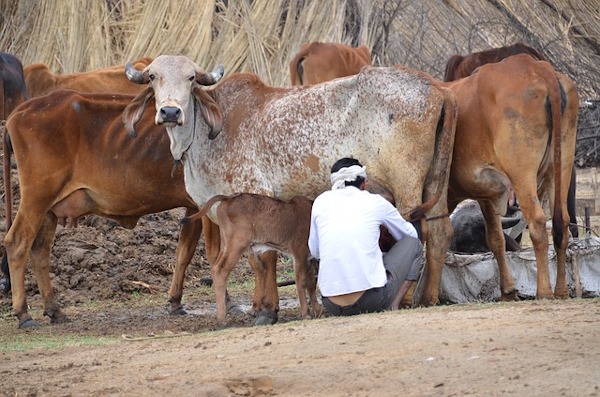Global Collaboration Division
Office of Academic Research and Industry-Government Collaboration
Hiroshima University
Naotaka Hirami: nhirami*hiroshima-u.ac.jp
Hiroko Nakano: nakanoh*hiroshima-u.ac.jp
(Please change * into @)
By Hiroshima University Department of Public Relations
Hiroshima University scientists will work on a low-cost sex selection system for bovines using their new technology to help grow dairy herds and boost the incomes of India’s smallholder farmers.

A farmer in India milking his cow herd. Hiroshima University researchers will work on a low-cost bovine sex selection model for smallholder farmers in India using a new sperm separation technique they developed. The system aimed to simplify the artificial insemination process is seen to improve the income of smallholder farming families by increasing the numbers of their dairy cattle that can boost local dairy production while reducing economic losses caused by the birth of surplus bulls. (Pixabay)
Hiroshima University scientists who developed a new sex selection method received a $2.7 million grant from the Bill & Melinda Gates Foundation to work on a simplified and low-cost artificial insemination system for bovines that could help improve living standards of India’s smallholder dairy farmers.
The sex selection technique Hiroshima University scientists developed successfully separated X and Y sperms in mice by utilizing the differences in the receptor genes expressed by each sex chromosome. Two receptors that play a key role in antiviral response and expressed only in the X chromosome — TLR7 and TLR8 — are responsible for slowing down the X sperms, making it possible to set them apart from the Y sperms.
Professor Masayuki Shimada and his colleagues at Hiroshima University’s Graduate School of Integrated Sciences for Life found that these receptors bind with the antiviral drug Resiquimod which suppresses the movement of X chromosome-bearing sperm without damaging it. Another test using the antiviral drug Imiquimod which TLR7 binds with showed similar results.
They found that in vitro fertilization (IVF) of the quickest sperms that swam up the test tube containing the solution led to mice pups that were 90% male. Using the slower swimmers that stayed at the lower layer of the test tube, on the other hand, resulted in mice pups that were 81% female.
This time, however, the researchers will work on crafting a sex separation system for artificial insemination — a process that is far more complex than IVF — that is affordable and can easily be replicated even by small bull centers in India, and eventually in Sub-Saharan Africa, at a low-cost to smallholder dairy farmers.
Artificial insemination systems for sexed semen currently available in the market like ST and Genus require high investments for lab equipment which translates to expensive costs for a dose of bull semen. Another drawback they have is the reduced semen viability leading to lower conception rates.
But the new system Hiroshima University scientists would develop is seen to cost farmers $5 at the most per bull semen dose. With investments in genomic technology, the bull centers can have access to sperm from improved bulls that can lead to increased use of improved genetic livestock by smallholder farmers. They plan to accomplish research in three to five years after which they will transfer the technology to India.
“The most beneficial point is that any special skills are not required. The other point is that scale-up is easy. These are very important points for the livestock field not only in developing countries but also in developed countries,” Professor Shimada said, explaining the merits of their new method.
He added that more than developing a technique, they aim to apply their research to address issues in livestock production.
His group had already developed an artificial insemination technique for pigs now used in more than half of porcine farms in Japan.
“We hope that the sperm sexing technique is used not only in Japan but also in other countries. This is very exciting for us.”
Their study caught the attention of the Bill & Melinda Gates Foundation after it was published in a scientific journal1 last year. The foundation’s work in India involves investments in research on crops and livestock so the technology can be accessible to smallholder farming families and efforts to combat pervasive malnutrition.
In 2018, the Food and Agriculture Organization of the United Nations released a study2 on the impact of dairy development on poverty reduction which said that “within livestock, the dairy sector is regarded as carrying particular promise to contribute to SDG1” or the goal to end poverty.
“Therefore, potential for future expansion of dairy production in developing countries remains significant and, if properly directed, dairy sector development could serve as a powerful tool for reducing poverty,” the FAO report said.
This coincides with Hiroshima University’s hope for research it produces to further contribute to the SDGs and global society.
Reference articles
1 Umehara T, Tsujita N, Shimada M (2019) Activation of Toll-like receptor 7/8 encoded by the X chromosome alters sperm motility and provides a novel simple technology for sexing sperm. PLoS Biol 17(8): e3000398. https://doi.org/10.1371/journal.pbio.3000398
2 FAO, GDP and IFCN. 2018. Dairy Development’s Impact on Poverty Reduction. Chicago, Illinois, USA. Licence: CC BY-NC-SA 3.0 IGO
- Profile of Professor Masayuki Shimada
- Official website of the Graduate School of Integrated Sciences for Life, Hiroshima University

 Home
Home














